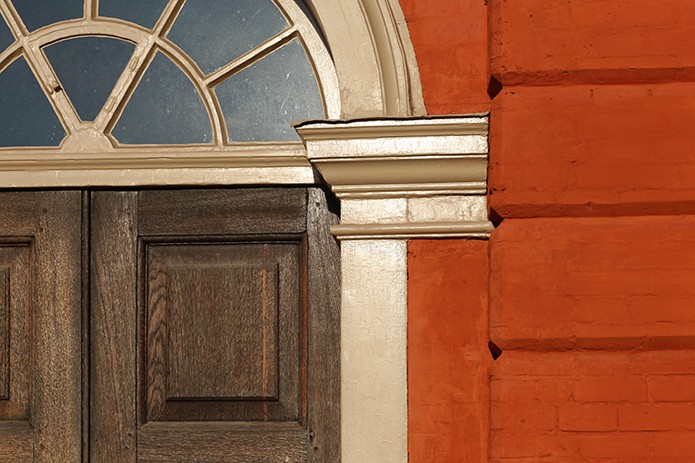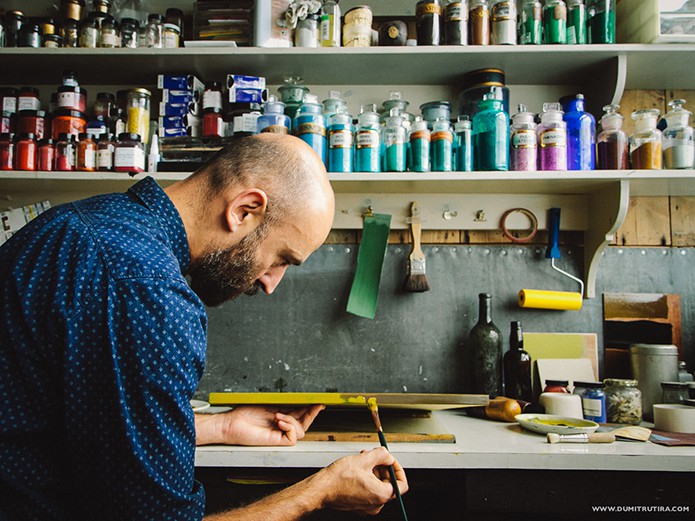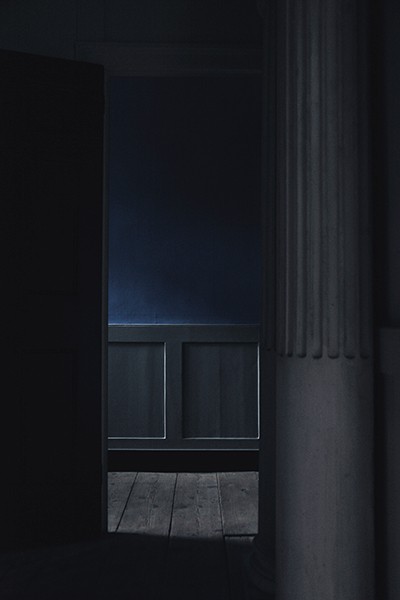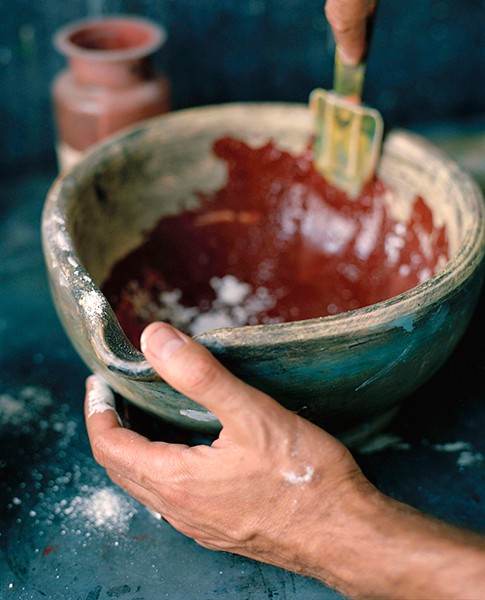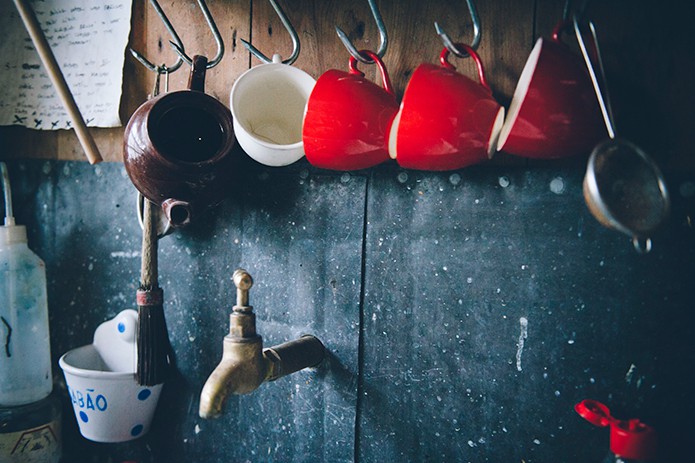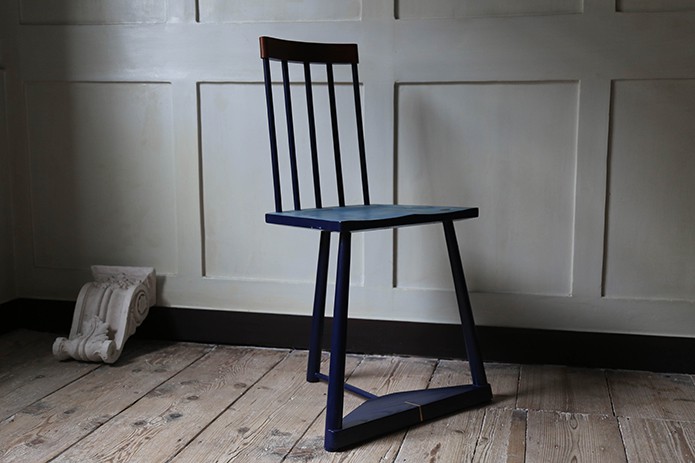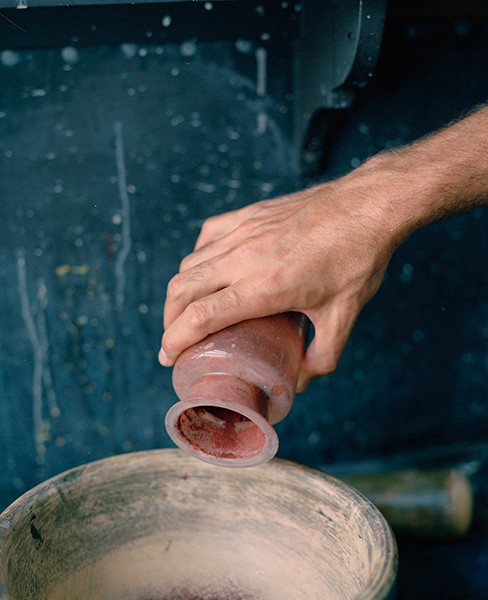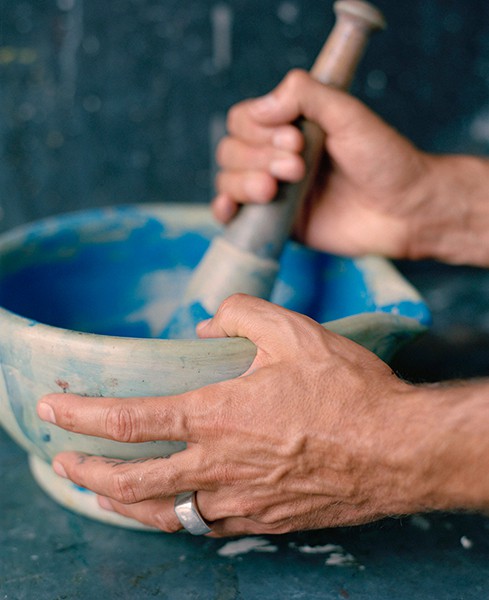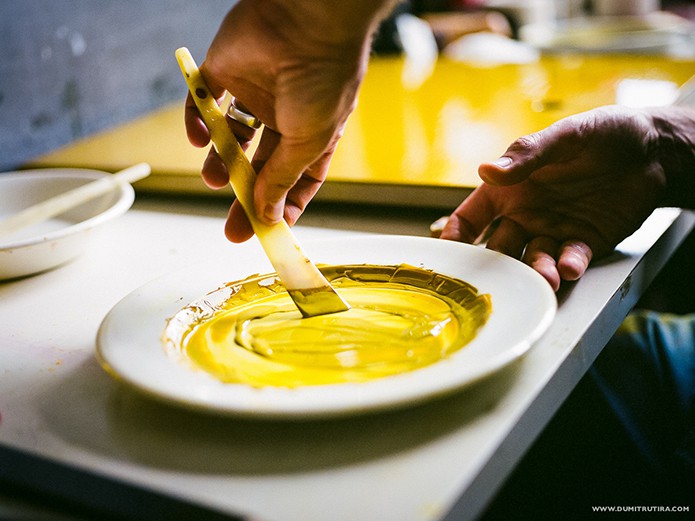
Mixing yellow pigment in Japanese Urushi lacquer
Pedro da Costa Felgueiras is a Japanner, in other words a lacquer and paint expert, with a passion for paints from the past. But, Pedro’s specialism goes way beyond the ‘heritage’ hues we are all familiar with on a paint palette brochure picked up at our local DIY store, as he uses wild, weird and wonderful natural materials (some of which, as seen in the title, you will not believe) and traditional techniques with absolute authenticity, time-consumingly true to historical research into how paints were made and used in centuries past.
It has been said that heritage is in Pedro’s genes; growing up in rural Portugal, his family gave him a firm grounding in the hand-made and reverence for the antiquated and authentic. So, it should come as no surprise that Pedro has become a revered restorer of long lost decorative schemes, working on restoring and reinstating the paintwork in iconic historical venues including UNESCO designated sites of historical interest and is now using his expertise and enthusiasm in designing and creating bespoke objects of his own.
Here, we are lucky enough to explore what inspires Pedro in his commitment to convincing colours and proper paints and what demarcates the authentically accurate from the present-day paint pretenders with titles inferring the likes of ‘Georgian Green’ or ‘Elephant’s Elbow’…
Firstly, for readers who aren’t familiar with Lacquer Studios please can you explain what you do?
I am an Historical Paint and Lacquer specialist. I work with old historical places such as Strawberry Hill House, Hampton Court and Kew Palace, amongst others. I am usually called in when decorative schemes are lost and only fragments survive. From historical evidence and knowledge, I reinstate the lost decorative schemes with historical materials and techniques only. I also design new pieces where I use the knowledge from these ancient materials and techniques to produce them.
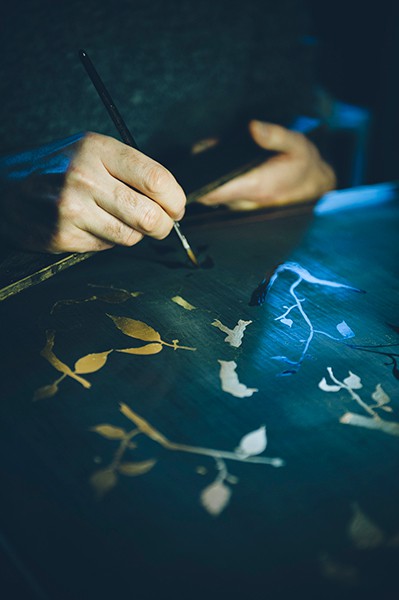
Applying gold size in a chinoiserie pattern on a blue Japanned surface. Private commission, the doors of a pair of cabinets
Becoming a historical paint specialist is a fairly unusual career choice. How did you get into it and what was it about understanding heritage paints that drew you in?
I was born and lived the early part of my life in Lisbon, Portugal. I was surrounded by old ‘things’. My mother’s office was in an old eighteenth century palace in the centre of Lisbon, my school was an old villa in Sintra and of course, Sunday mass was always in a church that was at the very least two hundred years old. Portugal at the time was also still very rural. My paternal grandmother lived in deep countryside in the very north of Portugal. From a very early age, I was exposed and very aware of handmade things and old methods of doing things. Everyone was very capable and dexterous with their hands. I actually have a vivid memory of my father straining his linseed oil paints. He didn’t use them because they were historical, but because they were what was available at the time. My mother was a couturier and both my grandparents had land to take care of in a very diligent way, from making wine to husbandry. So, making things in an old fashioned handmade way was sort of second nature to me. However, it was not until coming to London that I was really made aware of it. The London of over two decades ago was a very different place; I felt that there was a desire to preserve built heritage here more than in Portugal. Perhaps because London was so heavily destroyed during the war and so much was lost.
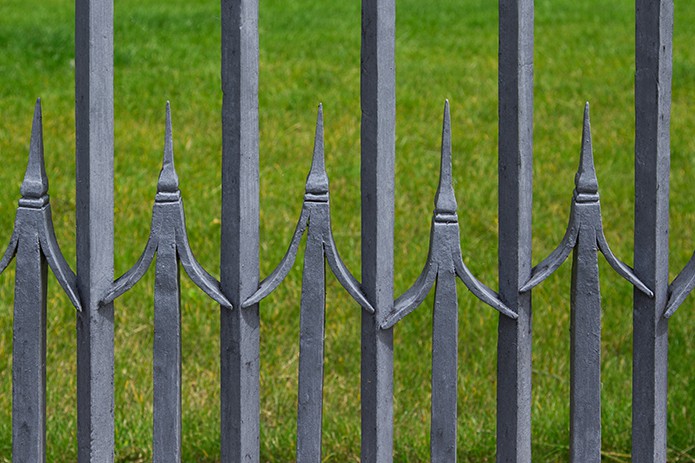
The Historical Linseed Oil Lead Paint on the Barge Walk Railings at Hampton Court Palace. This paint was made by using only the very same historical pigments and materials found in the microscopic paint analysis
Most paint manufacturers these days have developed their own range of historical colours. How close are they to authentic paints used in previous centuries?
The so-called historical ranges available from most paint manufacturers have absolutely nothing to do with historical paints or colour. They are mere imitations that vaguely resemble the original historical hue. Even the colours they offer are very much deteriorated by perceptions of what historical paints are. The colours offered by modern paint catalogues are also very much influenced by fashion. Not to mention, that the people that create those catalogues, very rarely, have actually ever mixed an historical pigment or media to know what actually they are imitating. Most modern paints are actually just plastic with a little dye and lots of bulking agents in order to maximise profits. In my over two decades of career, I have come across painted surfaces that have survived pretty much intact for three hundred years without flaking. Historical paints last actually for much longer. It is important to remember that many historic colours were achieved by applying multiple layers of glazes of different shades; this is not possible to achieve in one shoot, using a ready mix tin of paint.
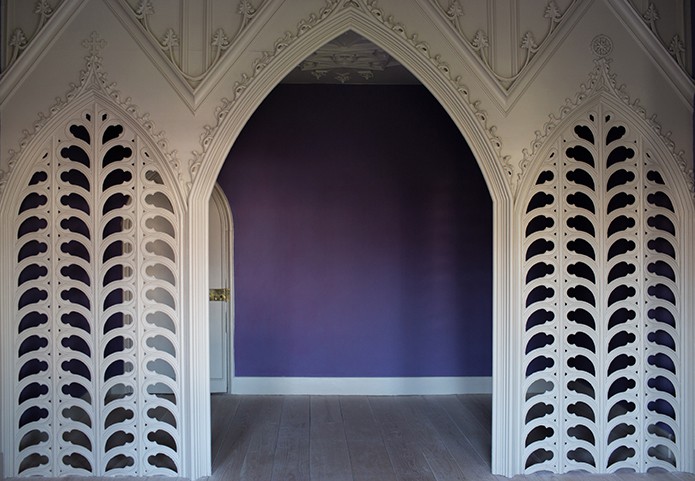
The Holbein Chamber, Strawberry Hill House. Ecclesiastical Purple distemper on the walls. A mixture of Cochineal and Pale Blue Verditer on rabbit skin glue distemper
What is so special about the properties of natural pigments and mediums within historical paints?
Real historical paints have a texture, an intensity of colour and reflect light in a way that is not possible to imitate with modern materials. Also, I very much believe, that if one is working within an historical context, it is important, when reinstating a missing decorative scheme, to use only authentic materials that were available at the particular given time that a building or object were created. To use modern paints that merely imitate a hue, with no reference whatsoever to the original materials, is wrong and misleading. Most of the buildings I work with are UNESCO designated sites of historical interest. It is important to use materials that reflect this. I think it is crucial that we educate present and future generations of what these building really looked like when they were first built, and not present them with a Disneyfied version of it.
For a novice interested in buying or make authentic heritage paints for a restoration, what advice would you give to them to ensure they are used correctly and adhering to authentic decorative colour schemes?
First of all, do not go to your local DIY store. You would be better off going to a good art supplier. Some of the historical pigments only survive as artist materials. Some, funnily enough, survive because they have found their way into the food or cosmetic industry, such as the cochineal (made from crushed beetles) which can be found in bright red lipstick and as a red food colouring agent. Other pigments only survive due to the perseverance or even the foolhardiness of one or two people that believe that they are still of value and inimitable. Using historical materials, according to popular perception, is believed to be harder to apply. I actually find historical paints much easier to make and apply. I believe that the most important thing is to accept that they are different from modern paints. The best thing is to forget everything that you know about painting and start from scratch. You also need to make your clients very aware that they are getting a different product and that they cannot expect historical paints to behave in the same way as modern paints. For example, you very rarely find a piece of antique furniture, with its original paint, that has been applied to a horizontal surface such as the seat of a chair or the top of a shelf. Shelves were mostly painted only underneath and on its edges. Authentic historical linseed oil paints can take a few months to fully harden if not applied very thinly spread.
Some of the colour pigments used in the past included crushed bones, beetles, flowers and rocks from inaccessible mines; I believe one old pigment even came from ground-up Egyptian mummies! Given the rarity of some of these pigments, how do you imagine future generations of heritage paint specialists will manage as they are becoming difficult, or impossible, to obtain?
Yes, this is a real problem. We really are at crossroads at present. We risk losing forever the know-how to make some of the age-old pigments and materials. For instance, I only know one person that is still making the Blue Verditer pigment. He is in his seventies, and I fear that when he is gone, many recipes to make old pigments will be lost forever. Blue Verditer was extremely fashionable as a water-based paint (distemper made with rabbit skin glue) for walls and even many background colours on hand-printed wallpapers.
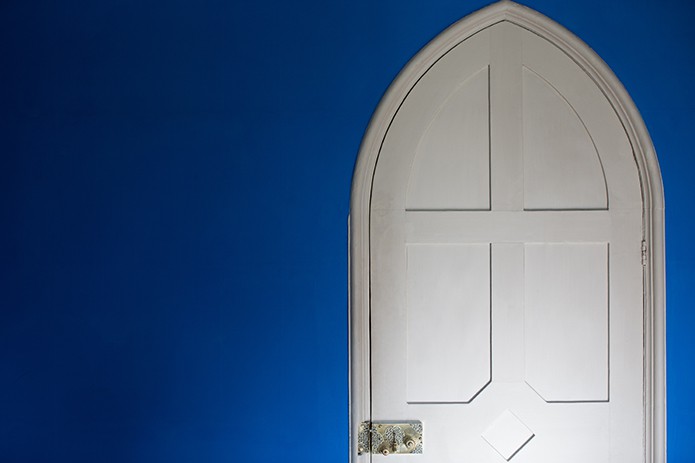
Blue Bedchamber, Strawberry Hill House. Blue Verditer pigment mixed in rabbit skin glue distemper. Walls covered in stretched canvas and papered previous to paint application. This was done with intent of protecting and ensure the longevity of these expensive paint finishes. The canvas would allow the background walls to move whilst avoiding the paint from cracking
Many historical houses throughout Britain still display this material on their walls. For this reason, I really believe that it is crucial that when embarking on any size of restoration project within an historical building that only historical materials are used – especially if these have any form of public funding. If historical materials are not used in major world renowned buildings, they will simply disappear forever.
What type of projects do you typically work on?
I work with historical buildings where it is crucial to reinstate missing schemes or where it is of the utmost importance to actually understand the original materials used. I am currently working on a project where a very highly decorative part of the same building vanished at the later part of the 18th century. The decision has been taken to reinstate this. Apart from the original architect’s drawings we did not have much information on these. However, after some historical research, descriptions of the pieces were found as well as some poems describing the type and quality of surface. Some 18th century sketches, drawings and paintings were also found. Based on this, and some paint analysis of the remaining surviving parts of the same building, I was able to ascertain that Copper Verdigris glaze was used. This material and colour were incredibly fashionable from the 1750’s onwards in Britain and the rest of Europe. In fact, we know that around the same time, George III offered a prize for the best Copper Verdigris glaze that could be produced.
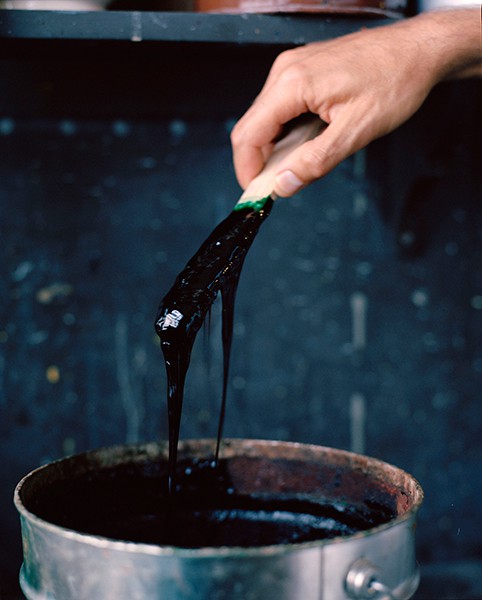
Copper Verdigris Glaze. A finish that was highly fashionable in Europe around the 1750’s. It appeared in three rooms in Strawberry Hill House, as well as the Great Pagoda at Kew Gardens. This is a colour that was very much associated with exoticism and in particular to China
Contemporary newspaper articles mentioned that five hundred pounds of this material were produced at the same time as this building was being erected. This green, glass-like colour did also become associated with exoticism, and in particular with Chinoiserie in the 18th century. Also, from a point of view of a craftsman at the time, this was an extremely efficient way of achieving a very gloss shiny, glass-like surface. Whilst with European lacquer (japanning) a shiny surface could be achieved with up to thirty layers of shellac, with the Copper Verdigris glaze, the same effect could be achieved within three layers.
How appropriate are heritage paints for a modern home – for instance, can they be applied over modern plaster skims, emulsion and glosses, or do they only work on older lime-based plasters and historic paints?
I have used Historical Paints within modern contexts when working with designers and architects. This was to satisfy very discerning clients that were looking for something that is dramatically different from modern paints. When it is not possible to remove layers of modern paints, the walls can be papered first and then the historical paints applied on top of the paper. In most historical grand houses, the walls were first covered in stretched linen, papered and then painted. This was done in order to bridge the different wall textures such as brick, wood and plaster – sort of an ancient version of plaster board… To first cover your walls in canvas and then paper prior to painting them, would also ensure that your decorative surfaces would remain flexible and therefore last a lot longer. Contrary to modern perception, in Georgian times, bright colours were actually very fashionable even if difficult to achieve and therefore expensive. When it was not possible to achieve a bright colour with paint due to the limitation of the materials available, even more expensive fabrics or wallpapers were used. Hence the emphasis in preserving them for as long as possible. ‘Drab’ colours also existed, but those were used mainly on timber to imitate stone hues.
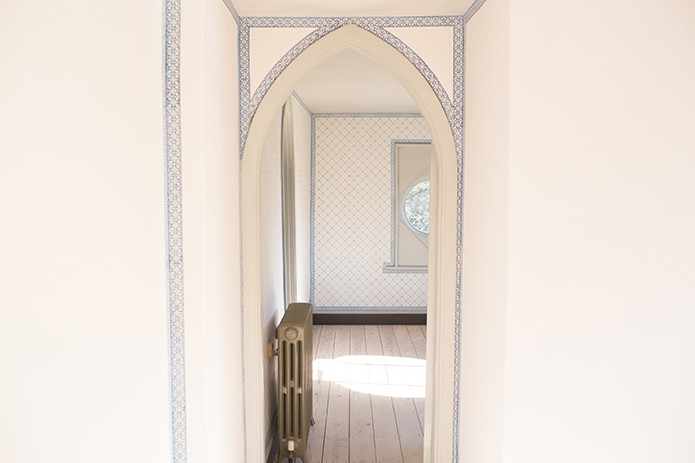
Plain white distemper finish applied in Horace Walpole’s private Chambers. In this instance, the soft white was achieved by mixing white chalk only into the rabbit skin glue distemper. The edges trimmed with handmade, hand-printed paper by Griffin Mill in Ireland
For a restoration, how do you know what colours and types of paints were used in the past, between certain dates – are you referring to books on historic design and decoration to provide information on context and use, or are you taking and analysing colour samples to understand pigments and medium used?
It is important to know when pigments were first invented and used. We know very clearly when some pigments were first used and got superseded by new replacements due to advances in technology and industry. You can very clearly tell the history of a paint strata when analysing it under the microscope. For example, if we have Prussian blue, we know the paint was applied after 1705, if you find ultramarine blue, you know that the paint was applied after 1800. However, if Prussian blue is found to be mixed up with Titanium White rather than Lead White, we know that it was applied after the 1920’s when Titanium White was first invented as a pigment. The most important information is what you can gather in situ, from parts of the building or object that belong to the period you want to reinstate. You back this up with historic research.
I understand some of the pigments and mediums used in creating heritage paints are quite ‘distinctive’, with smells ranging from Camembert cheese, fish to rotting meat. How long do these smells last for once applied, and how are they tolerated by fellow workers within the restoration team?
Yes, the smells of historical paints are quite distinct. These smells only last for as long as the paint remains wet or is sanded down once it is dry. When I first started working at Strawberry Hill House, where a lot of the paints were actually rabbit skin glue distempers, I got a very adverse reaction from the volunteers that were working at the parts of the house that remained open to the public. I actually mixed the paint from scratch onsite, first by melting the rabbit skin glue granules and then grinding the pigment into it. So, the smell was at its most intense. However, once I explained that this was the most natural of ingredients and completely historically correct and even gave them a demonstration of how they could make it themselves, they loved its characteristic smell from then on. In fact, the director of the house at the time said that in many historical houses, period music is played to evoke the correct epoch of the building. However, he felt that the smell of the Historical Paint was a much more correct rendering of the time of Horace Walpole – as he himself would be in a constant flurry of redecorating and using the very same materials. For myself, I much prefer the smell of rabbit skin glue distemper, often described as putrid, to the smell of very strong and toxic modern paints.
I believe you have recently begun creating a range of bespoke products which include some of the methods you have developed in creating your heritage paints. Can you elaborate on this?
I use this know-how of old materials and historic expertise to inform my newly designed pieces. As a designer, I am very comfortable with historic pieces as well as modern works of art. Perhaps it is my background in interior design and my job in fashion in Portugal, combined with my conservation studies in London, that make me very comfortable with both antiquity and modernistic pieces.
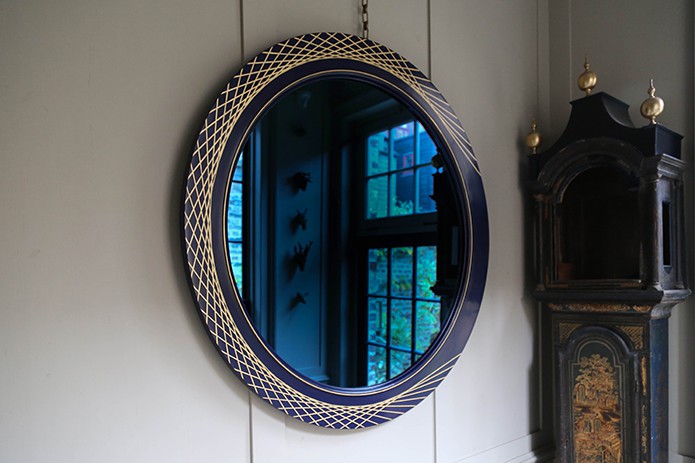
Newly designed piece for the Crafthouse in collaboration with the New Craftsman. ‘Oculus Mirror’ 2016. Historical paint finish in blue pigment. Gold line decoration in the ‘Fugitive Line’ pattern. Blue tinted mirror plate
One must not forget that all the now-historical houses were highly curated works of art in their own right when first built. One of my favourite quotes is from Eileen Grey; she said that having been brought up in an eighteenth-century house in Ireland was a crucial influence in her work, as a Georgian room is basically a beautifully proportioned white cube with decorative embellishments. I love seeing my pieces being well-used, in a well-lived environment mixed up with other great works of art. One of the tables I was commissioned to make was used as a base to place a medieval, beautifully carved polychrome statue of saint George slaying the dragon with a Joseph Beuys blackboard behind.
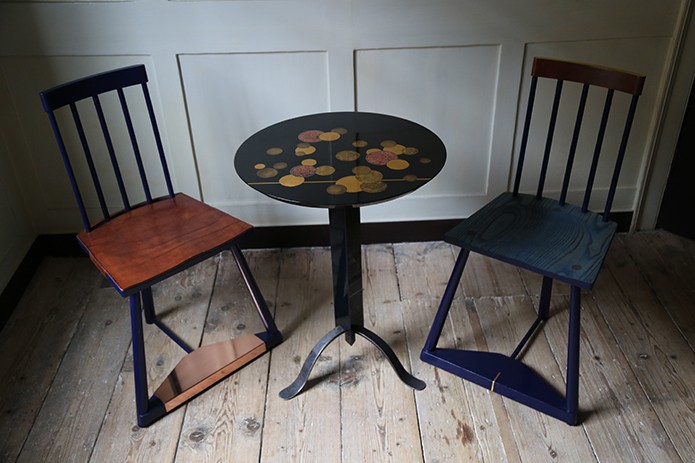
Two of the Pilgrim Chairs series. Inspired by Chaucer’s Canterbury Tales characters. ‘Madame Eglantine’ 2016 and ‘The Wife of Bath’ 2016. Historical paint finishes and British oak tanned leather. ‘Candelabrum Table’, 2016. The base is inspired by a Georgian rush candle base. The decorative design inspired by Japanese ceramics and lacquerware. The disques often appear as motifs representing noble families crests and coat of arms. In here they have been presented in a stylistic manner, as a vehicle for different gold sprinkling techniques
I like mixing all periods together; it is the quality that holds them together. It does not matter if one is made 400 years ago, another 50 years ago or yesterday. I think you can see this in my newly designed pieces. I have recently designed a set of chairs called the Pilgrim chairs- inspired by characters in Chaucer’s ‘The Canterbury Tales’.
You did a degree in Conservation Restoration for decorative surfaces. Does all your knowledge stem from what you learned on this course, or have you had to go out and revive old techniques, and if so, what is your starting point?
In Portugal I did a course in interior Design and Art History. In London, I did a BSc in the Conservation and Restoration of Decorative Surfaces at the Sir John Cass faculty of Art, Architecture and Design. I did learn a lot then. But this was a very superficial knowledge on a very varied spectrum of techniques. After this, I spent about 7 years with a college tutor of mine, exploring old workshop manuals dating from the 17th to the 19th centuries. This period in my life is actually crucial for everything that I do now. To have had the time to explore and to get to know these books, to get to decipher their poetic language (in contrast to analytical lists of ingredients found in modern recipes) and to actually understand the materials mentioned and used, I consider to have been essential in understanding historical materials and techniques. My love and enthusiasm for these materials comes from this. I consider myself extremely lucky to have had the privilege at the beginning of my career to work with someone than can possibly be considered eccentric, Margaret Ballardie. We shared the same passion for old methods of making beautiful things.
In your 25-year career so far, have you noticed any shifts in understanding of Georgian colour schemes, possibly even as a result of your investigative work?
I think that we still have a long way to go in respect of the understanding of Georgian colours, especially when concerning the use of historical paints versus non-historical modern paints within a building or piece of furniture of historical interest. From an educational point of view, it is important that we must stop using modern paints in historical buildings for the sake of educating present and future generations. We are not working on these buildings for our own pleasure, but because it is our duty to preserve these very same building for future generations. This is our cultural heritage. However, on your question of modern paint catalogues, historical ranges seem to be starting to understand that Georgian colours were not all drab; on the contrary. Catalogues from a few decades ago only display colours that are very ‘dirty’ or even very ‘green’ in hue; I guess that this was an attempt to imitate an aged paint film rather than understanding or knowing how an 18th century paint film looked like when it was first applied.
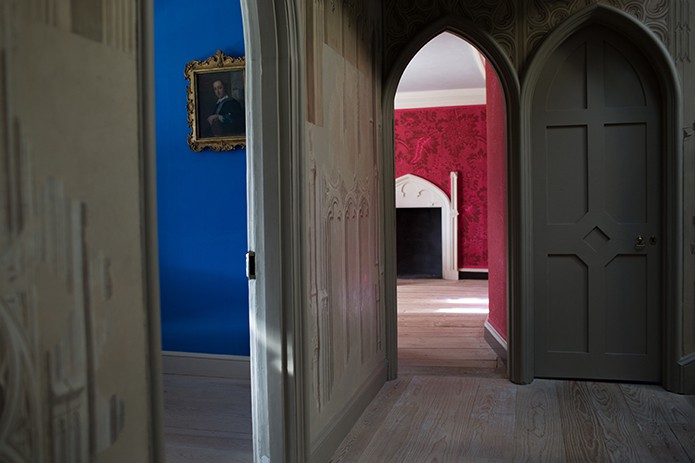
The staircase at Strawberry Hill House. Contrary to modern perceptions, 18th century colours were not drab. All the bright colours in this image were used as a status symbols as they were expensive and difficult to achieve. What could not be achieved with paint, fabric was used instead as a bright colour was fractionally easier to achieve by dying cloth. The so-called drab colours were used to make lesser noble materials look more expensive, such as painting wooden columns to look like stone
Finally, what advice could you give to someone interested in a career in conservation restoration and heritage paints?
For someone interested in pursuing a career in conservation or Historical Paints, what I would say is that it is probably going to be a lot of hard work grinding all those pigments and applying miles-and-miles of it on those massive historic houses. However, I can assure you that it will be really rewarding and that you will learn a lot throughout your career. Do it because you love it and always persevere. And remember that old craftspeople did not go to the shop to buy a tin of ready mixed paint but did it all themselves from scratch.
Thanks to Pedro da Costa Felgueiras for taking time out of his busy schedule to answer our questions. All images courtesy of Lacquer Studios.


